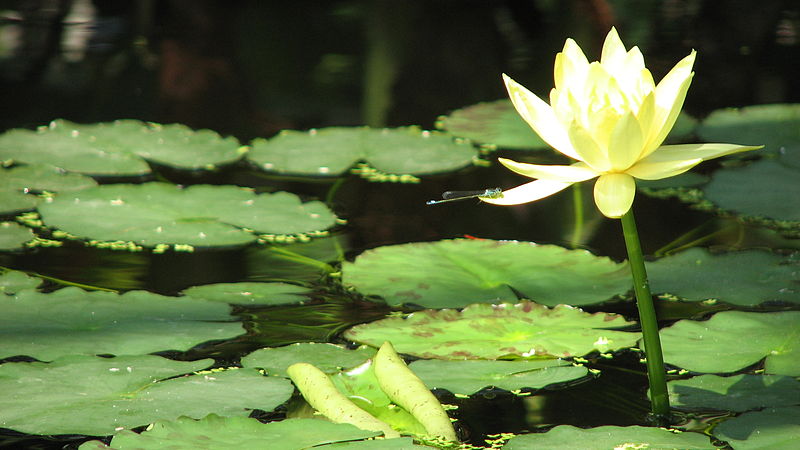Nymphaea
|
Family: Nymphaeaceae |
Rhizomes branched or unbranched, erect or repent; elongate stolons present or absent. Leaves mostly floating (vernal leaves submersed; blades sessile, broad). Leaf blade orbiculate to widely ovate or elliptic, basal lobes divergent to overlapping, margins entire to spinose-dentate, apex of lobe acute or acuminate to widely rounded; primary venation mostly palmate, midrib with 1 vein. Flowers floating or emersed, opening diurnally or nocturnally; perianth perigynous, spreading at anthesis; sepals 4, mostly greenish, ovate to elliptic; petals 8-many, spirally arranged or wholly or partially whorled, showy, white, pink, blue, or yellow, broadly lanceolate or ovate to obovate, grading into stamens; stamens yellow or cream-colored, inserted on lateral surface of ovary, spreading at anthesis, sometimes with distal connective appendage; ovary shorter than petals and stamens; stigmatic disk with prominent, distinct, upwardly incurved appendages around margin. Fruits borne on curved or coiled peduncles. Seeds nearly globose to ellipsoid, to 5 mm; aril present. x = 14. Nymphaea is an important genus of ornamental plants, with numerous cultivars or wild forms grown in water gardens. Some have become naturalized in some places, particularly in Florida, and two such taxa are included in this treatment. A third, N . × daubenyana W. T. Baxter ex Daubeny ( N . micrantha Guillemin & Perrottet × N . caerulea Savigny), with blue flowers and entire leaves and with a proliferous mound of fibrous tissue above insertion of petiole, may also be encountered in Florida. Prior to conservation in its current sense, the name Nymphaea was frequently used for the genus now known as Nuphar .
STEMS: ovoid to cylindric rhizomes, often sprouting freely. LEAVES: glabrous or pubescent, elliptic-sagittate to orbicular, entire to spinose-dentate, the apices acute-tapered to truncate, the bases cordate to sagittate, the venation mostly radiate with a prominent midvein, glabrous or pubescent. FLOWERS: floating or raised above the water surface, strongly to faintly odorous; sepals 4 (rarely 3 or 5), green or streaked with red; petals 7-40, showy, white, blue, red or yellow, in various shades; stamens numerous (20-700), multiseriate, the outer ones with broad petaloid filaments, the inner ones slender to filiform; staminodes present; pistils with 5-47 carpels, united or partially united; stigmatic disk broad, concave or almost flat, radiate; ovary multi-locular, ovules numerous in each locule. FRUIT: a berry-like capsule, fleshy or spongy, ripening under water. SEEDS: small, with a floating membranous bell-shaped aril. x = 14. NOTES: 40-50 spp., nearly cosmopolitan. (Name from the classical water nymph, Nymphe). Wiersema, J. H. 1987. Syst. Bot. Monogr. 16:1-112. REFERENCES: Ricketson, Jon. 1995. Nymphaeaceae. J. Ariz. - Nev. Acad. Sci. 29(1). 26. Sep 4, green; pet numerous, white or pink, inserted on the ovary; stamens numerous, inserted on the ovary; inner stamens with linear filament and long anther, the outer with progressively widened, petal-like filament and shorter anther; stigmatic disk with 6-30 radiating lines; lf-blades floating, rotund or elliptic with a basal sinus; petioles and peduncles with 4 large air-passages. (Castalia) 30, widespread Gleason, Henry A. & Cronquist, Arthur J. 1991. Manual of vascular plants of northeastern United States and adjacent Canada. lxxv + 910 pp. ©The New York Botanical Garden. All rights reserved. Used by permission. |

